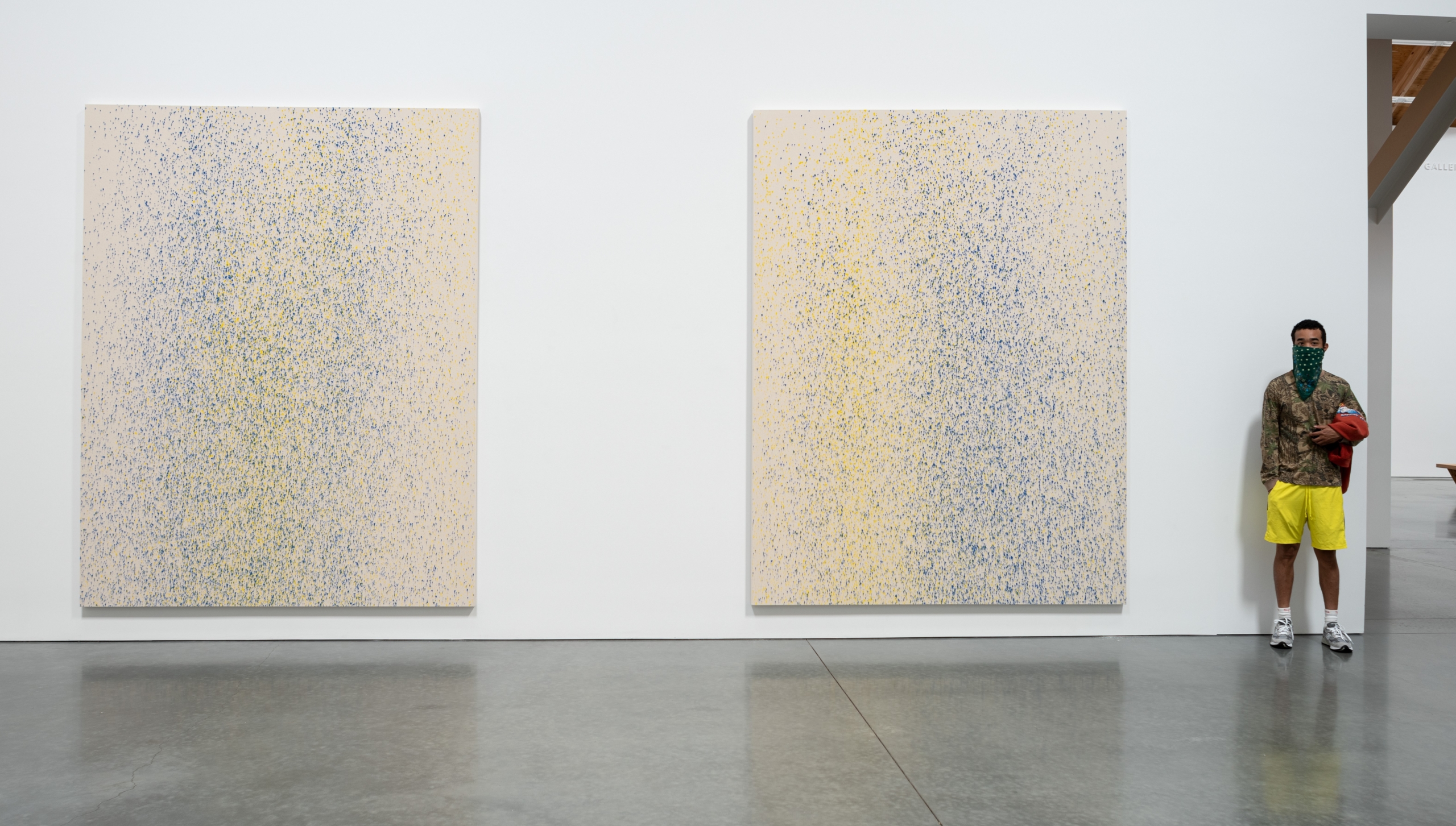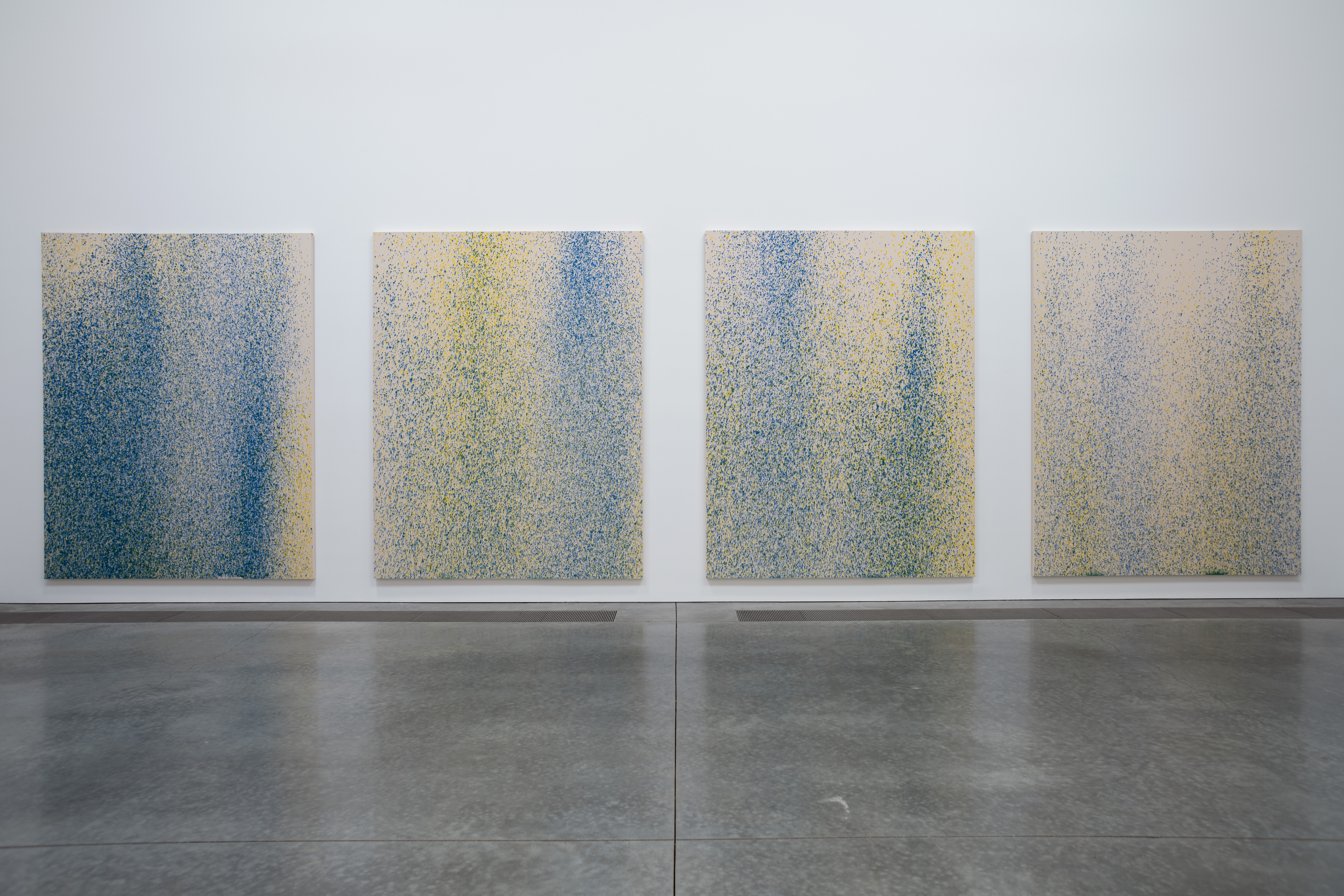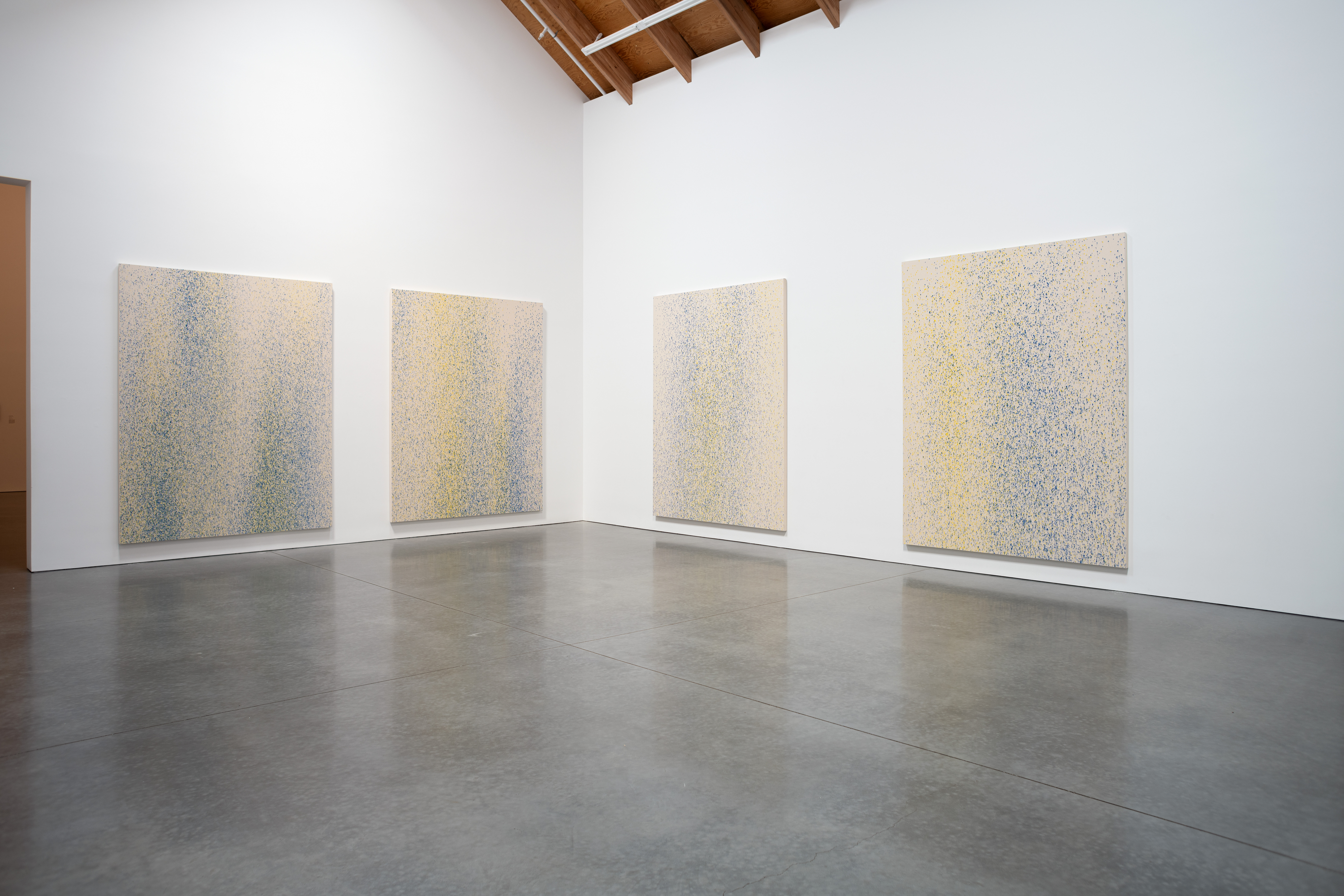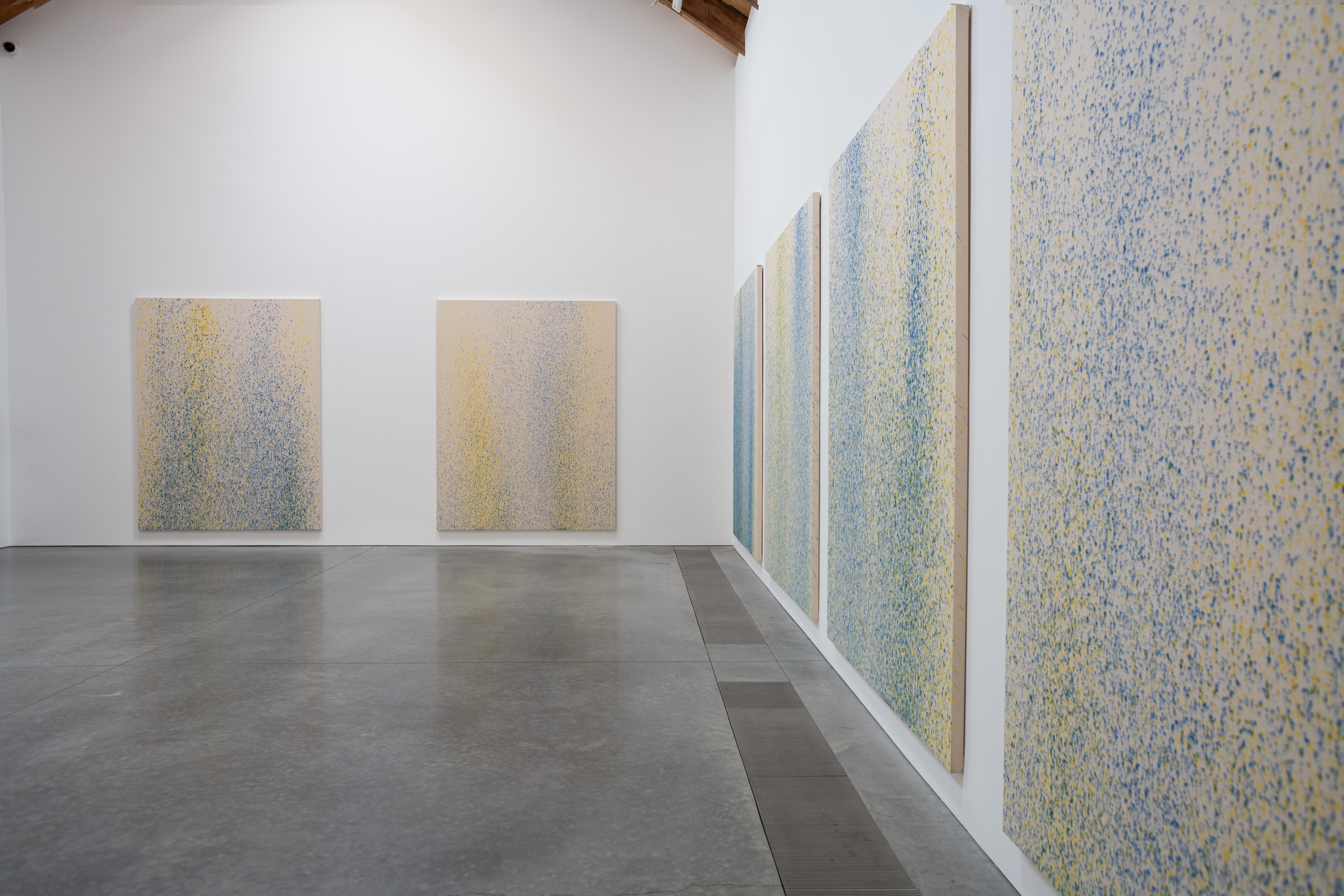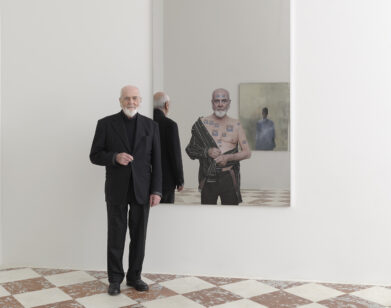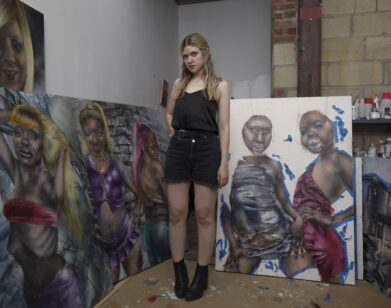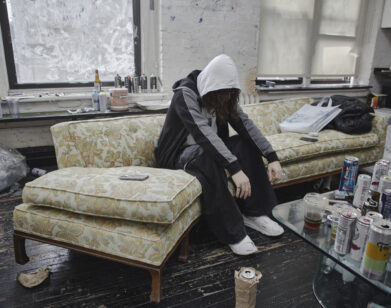q&a
Lucien Smith Wants to Be the Jeff Bezos of Nonprofit Directors
Once called a “wunderkind” by The New York Times for his sell-out gallery shows and astronomical auction values, the 31-year old artist Lucien Smith has given up on “playing ball” with the art world. “I haven’t set foot in a New York gallery in years,” he says. Now residing in Montauk, the artist, who has long refused gallery representation, maintains a comfortable distance from the politics of the New York gallery ecosystem. There, he devotes much of his time to his nonprofit organization, STP (“Serving the People”), which offers a digital platform for emerging artists to exhibit and sell their work.
While Smith’s studio practice is no longer his main occupation, the art world has not forgotten the impact Smith’s work made on the market in the early 2010s. Discovered by dealer Jeanne Greenberg Rohatyn at his BFA Thesis exhibition in 2011, Smith’s paintings quickly caught the attention of major art collectors. Speculative buyers feverishly acquired his paintings, reselling them at auction two years later at an enormous profit. Art critic Walter Robinson coined the term “Zombie Formalism” to address the bubble emerging in the market for Smith’s work, as well as that of other young contemporary abstract painters at the time, including Jacob Kassay and Aaron Aujla. Robinson contended that the works of these artists resurrected the aesthetics of their Abstraction Expressionist predecessors, without expanding the conceptual concerns of the AbEx movement. As “Zombie Formalism” gained popularity as a category, the bubble eventually burst.
Years after receding from the spotlight, a new exhibition of his work at the Parrish Museum in Water Mill, New York has given Smith another opportunity to reflect on this formative period of his career. “Lucien Smith: Southampton Suite,” the artist’s first institutional solo exhibition, centers on the Rain Paintings, Smith’s best-known series, for which he used a fire extinguisher to spray pigment across each of the canvases. Interview called up Smith at home to talk about the show, life in Montauk, and the artist’s lofty ambitions for his growing nonprofit.
———
ELLA HUZENIS: What was it like for you to be out in Southhampton back in the summer of 2013 working on this particular set of Rain Paintings?
LUCIEN SMITH: I guess 2011, 2012 were my breakout years. I introduced the Rain Paintings and then had some success. And 2013 was really the first summer that was all sinking in. I had moved already from my Upstate studio, so I no longer had a place to work outside. And then a gallerist of mine at the time, Jeanne Greenberg, offered me her house to make some paintings. I spent that summer out there just revisiting the Rain Paintings and really just trying to perfect them.
HUZENIS: Your Rain Paintings have also attracted some controversy, as they’ve been taken up by critics as this emblematic example of “Zombie Formalism,” and the aggressive trends in flipping and speculation that played out in the market for many emerging artists in the 2010s. Does that controversy affect your read on these works today? What is it like to look back on them in a museum context?
SMITH: I mean, it’s definitely a therapeutic experience for me, as far as being able to take something from the past that was a little bit good and a little bit bad and be able to put it in this context, that people, especially in a time like today, can appreciate it and relate to, and I think it’s enlightening and definitely helping me move forward.
I’ve never lost faith in these works. It’s just that the superficial part of the creative industry tends to pay more attention to auction prices and gossip, which is just… I didn’t start painting to have to deal with that stuff. I just block that stuff out.
And obviously, now that it’s in a museum, people take it in a whole new perspective and it’s a wow factor and they’re so proud and happy. But a lot of those people were the same people that were criticizing how many Rains I made or how much they’re selling for, which goes to show how much that institutional support can help an artist and why galleries love to manipulate that and really push their collectors to donating works to museums and things like that. But no, my position and my relationship to my work is always the same.
HUZENIS: Do you think your relationship with painting has changed since 2013?
SMITH: Tremendously. The process of painting and art-making at one point definitely was uninteresting to me because of all the other stuff that clouded it. It seemed like even if I was making a painting in a vacuum, somehow it was affected by someone’s criticism, which I understand. As an artist, I’m opening myself up to that critique, but at the same time, those critiques very rarely speak about the art and more or less [speak] about everything but. At first, STP motivated me to make art because I was able to finance the organization. And then meeting younger artists and seeing how creating art and monetizing it can be used in a healthy way continued getting me into that rhythm, where now I’m definitely excited about painting, in some sense.
I think at this point, I look at what I did to the art market in 2011 and 2012 as part of my practice, like disrupting. I use painting as the vestibule for that sort of disruption. I’m thinking about painting less in a traditional or formal sense at this point and more just thinking about what I can do to expose inequalities or imperfections in the industries that I revel in. That could be through the organization. That could be a capsule collection. That can be a film. It doesn’t necessarily need to be a painting at this point.
HUZENIS: It seems like mentorship is part of STP’s mission. You’re sharing your experience, and trying to help artists work and find success in a way that’s sustainable. How do you feel about occupying that kind of “mentor” role?
SMITH: Man. I don’t know if I would consider myself a mentor, but I hear what you’re saying. I think that the only thing I can do is teach people my personal experience and allow them to learn from that, if they choose to. And so, a lot of the platform that I set up is set up in a way as something that I really wish I could have had as a younger artist. And so, by being able to provide that to the next generation, for me, in some way, is alleviating.
It’s allowed me to forgive and move on from a time that may have been a little traumatic. I guess that is some a form of mentorship. What I hope to create with STP is an ecosystem where artists can be mentoring each other and allowing for that to take place, because it really shouldn’t be about me.
HUZENIS: Was that kind of collaborative format inspired by the model of art school, or did you find that that sort of space for dialogue was lacking in your own art school experience?
SMITH: Art school was amazing because you have critiques and you have this community that you’re forced to be a part of, and you can either learn to take advantage of it and use it or you can neglect it and when your four years are done it’s over. And a lot of my professors would always say the same thing: ”You should really take advantage of this time where people are having to sit here and give you these 10 minutes to talk about your work because outside of school, it doesn’t really exist unless you become a famous artist,” which I did, which unfortunately, a lot of people don’t.
And I just thought that shouldn’t be the case, whether you’re going to art school or not. I feel like everyone should have a place to be able to talk about themselves and the things that they’d make and the world, and have this really diverse conversation that’s ongoing.
STP itself is one, giant, collaborative project. It is definitely a work of art that is not necessarily just mine. It belongs to a lot of people. I’m not too involved or concerned with my own studio practice. It is what it is. I’m not sitting in the studio every day trying to brainstorm new series of paintings. That’s just not a very good way to spend my time or use the skillsets that I have.
HUZENIS: You’ve mentioned in past interviews that working with artists through STP has given you a more hopeful outlook on art and the art world.
SMITH: I think coming into the art world and art market at such a young age, I always had to fight against the bias or insecurities of the older generation, pushing up against that and having to really either fight for their approval or just reject the system in a way. I foresaw the crash of the gallery system. Maybe it’s because of COVID now, but what I think, and what I seem to see happening, is that a lot of galleries are just not able to function. They’re getting out marketed by these larger, blue-chip, Gagosians, Zwirner, Hauser-type galleries. I think a lot of those gallerists are going to end up either merging or closing and going and working for other dealers. If you start to think about the really small Chinatown, East Village galleries, there’s definitely no place for them at this point. That’s kind of why we started STP: to unify a lot of that energy instead of having these galleries compete with each other and having this thing where younger gallerists spend their whole lives or all of their energy creating these really amazing careers only to have them poached by bigger galleries.
STP is definitely trying to address some of that stuff. I would say that art is not that important, and so our mission is very much more geared toward helping society by using creativity, and not just fixing the art world or art market’s problems. An expert is someone who makes the most mistakes in a very narrow field, and I feel like I’ve made a lot of mistakes in art. And so therefore, it is our entry point, but it’s definitely not this thing that we will continue to focus solely on, in the same way that Google started out as a search bar. Now Google does so many things.
HUZENIS: What spaces in particular are you interested in expanding into with STP?
SMITH: We’re already starting to do film festivals. I think we’ll do additional films festivals this year, music releases, and production. We started an editorial blog, which is open to our viewers contributing, very much into non-curation. The editorial section of STP for me right now is really interesting because we’re starting to work with food editors and music editors and film and just create a voice for it that is multi-perspective.
This sounds crazy, but I would love to go into healthcare policies and do things with money using art that the government is too. It takes too much paperwork to do in the same way that Jeff Bezos could save an entire continent of starving children right now with a percentage of what he makes in a few days. That’s the decision-making I think that we would be able to do eventually.
HUZENIS: You said in an interview recently that, while you’ve been developing STP for about five years, you feel like this year is the first that it’s really begun to pick up steam.
SMITH: Five years ago, I started self-quarantining and isolating myself from society because I felt like an outsider. I spent those last five years really looking at the world and looking at myself. I think this year, people are starting to feel like I felt five years ago, disconnected and unhappy with the way the world is. And I think because of that time in early quarantine, where people had to really sit with themselves, something like STP really appealed to a certain type of person as an opportunity to actually use their creativity and their time to immediately do some change.
HUZENIS: What it’s like building this digital community through STP, while living mostly in isolation in Montauk?
SMITH: It’s just much easier for me to get stuff done and to communicate my point. I’ve spent a lot of time talking to people all day through Zoom and on calls and just I’m just much more effective. I think it’s much easier to help society if you’re outside of it. You have more leverage. I think sometimes it’s very easy to get caught up in the world that’s physically around you, but for me, being able to work from a place of tranquility and peace and serenity keeps me healthier and in a mood where I can have better performance.
HUZENIS: Do you think of yourself as an introverted person?
SMITH: Definitely. I definitely get more energy from being alone. Being around people, especially in the daytime, really drains me. I’ll need to spend a few days just gathering my thoughts again. I think I’ve always been like that as a kid. I definitely moved out here because of that quality.
HUZENIS: Are you attracted to the sort of quintessential Montauk vacation-lifestyle—surfing, fishing, that kind of thing?
SMITH: I mean, at least early on, I was really into that stuff. I think now, especially in the summer, it’s a little bit cringe because it’s a lot of “bridge-and-tunnel” types that are hungover, walking around half-naked. I’m not really into that, but I get it. Those people need to escape the city and their lives too, so I’m not judging them for who they are. It’s just—I try to not spend too much time out there with them.
Normally, I’m at home all day. I’ll do a few calls. I’ll do some yoga or meditation. I know a few beaches out here you can walk to and walk on and there are not many people there. I also built a house for myself here that is tailored to my needs, so it’s definitely a huge comfort zone for me.
HUZENIS: What are you looking forward to next in developing STP?
SMITH: One of the goals that I’ve always had is for this thing to run itself and be run by the same people that use it. And for me, my real responsibilities as a founder are to just continue to innovate the platform and offer more functionality to wider and wider audiences as we build. I pretty much fund STP at this point, so right now, I’m working on building a board and starting to fundraise. And the museum shows really help that because I’ve been able to meet the type of people who want to support the arts and want to help the younger generation. It does look like we are going to be able to meet our goal, and if STP can fund itself, and all I have to do is just sit back and watch people use the platform. I mean, maybe I’d be bored and try to find other ways to innovate, but it would be a dream come true to see that thing really just do itself.

